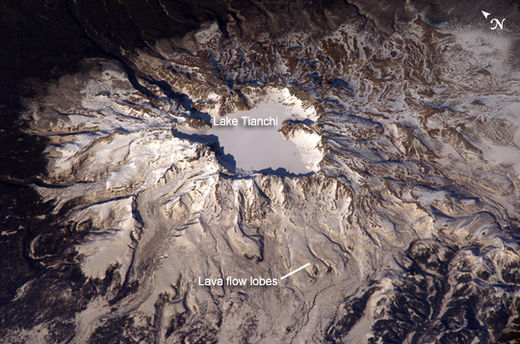
A South Korean geological expert has warned that the volcano - which last erupted in 1702 - could erupt sometime around 2014 and 2015.
If the volcano, located on the border between North Korea and China erupts, damage could be 10 to 100 times greater than that caused by the April 2010 eruptions in Iceland.
One of the largest known eruptions in the past 10,000 years occurred at Baitoushan Volcano (Mt. Baekdu) around 1000 A.D., depositing erupted material as far away as northern Japan - a distance of approximately 1,200 kilometers.
Sometimes billed as the largest eruption in the history of mankind, the eruption of the 2,744 meter-high mountain was about 50 times stronger than that of Mt. Vesuvius in 79 A.D. which buried and destroyed the Italian city Pompeii.
That eruption also created the 4.5-kilometer-diameter, 850-meter-deep summit caldera now filled with the waters of Lake Tianchi.
Experts predict that ash from a new eruption would severely damage the Korean Peninsula, China, Japan and Russia.
A growing number of scholars have linked the collapse of Korea's ancient kingdom, Balhae, with the eruption in the 10th century.
One theory comes from Professor Hiroshi Machida of Tokyo Metropolitan University, who first presented his theory in 1992 that the eruption of Mt. Baekdu (Mt. Changbai in Chinese) led to the fall of Balhae, which had expanded its sovereignty to the vast Manchuria territory.
Geologists predict the occurrence of great Mt. Baekdu eruptions every 1,000 years, and of minor eruptions every 200 to 300 years. Minor eruptions were recorded in 1413, 1597, 1668 and 1702 with the last activity being recorded in 1903.
Among other indicators of a future eruption is the height of Mt. Baekdu, which has grown nearly 10 centimeters since 2002. Experts say an expanding magma pool, a precondition for an eruption, is gradually pushing up the height of the mountain as well as the temperature on the surface.
On Oct. 1, 2006, a Russian satellite found the surface temperature of the mountain notably higher than before. And according to John Search of volcanolive.com, temperatures in a spring on the northern flank have increased by a few degrees over the past few decades.
Temperatures in the spring are now over 80°C (176°F!)
Mt. Baekdu has been carefully observed since 1999 when a volcanic observatory was built in China. Seismic activity near the mountain has increased dramatically since 2002, and the concentration of hydrogen and helium emissions, both of which are volcanic gases, have risen 10-fold.
If Mt. Baekdu erupts, the biggest immediate threat is the 2 billion tons of water in Lake Tianchi. An eruption would likely cause severe flood damage, engulfing roads and homes within a 30-kilometer radius within hours, a geological report found recently.
If volcanic heat evaporates the water and is mixed suddenly with volcanic ashes, it would be strong enough to engulf even Vladivostok in Russia and Hokkaido in northern Japan, according to experts.
"The magnitude of the 969 ±20 AD Baitoushan eruption lies between that of Tambora (1815 AD) with 87 cubic km magma and Krakatau (1883 AD) with 10 cubic km magma," says John Search of volcanolive.com.
That figure certainly doesn't sound like the largest volcanic eruption in 10,000 years. However, Tambora did cause "the year without a summer" in 1816, so we could still be talking about a cooling planet. Especially if a whole slew of other volcanoes erupt at about the same time.



Reader Comments
to our Newsletter